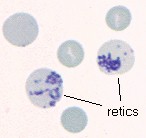|
Reticulocytes
Reticulocytes ("retics") are young, anucleate erythrocytes. They are released to
the blood in increased numbers as
a response to anemia caused by
hemolysis or blood loss in most species
(horses are a notable exception).
 Reticulocytes in canine IHA
Reticulocytes in canine IHA
|
They are called reticulocytes because when stained with a supravital stain, such
as new methylene blue, cytoplasmic RNA is precipitated into a reticulum-like
network (see picture at right). These same cells, when stained with routine
polychrome stain (eg, Wright's, DiffQuik), are termed polychromatophilic.
Mature erythrocytes, which are no longer synthesizing hemoglobin, do not
contain enough RNA to undergo this reaction when stained with NMB. The
RNA can also be stained with fluorescent dyes, such as thiazole orange,
which is then detected in a flow cytometer. A similar fluorescent technique
is used by the Advia (using Oxazine 750) to detect reticulocytes in dogs.
Evaluation of the reticulocyte response is an initial step in characterizing anemia
in species other than the horse. If the number of retics is increased in an anemic
animal, it is a sign that the anemia is "regenerative" in character. Regenerative
anemias are caused by loss (bleeding) or destruction (hemolysis) of erythrocytes
from the peripheral circulation. Anemias without increased reticulocytes are termed
"non-regenerative", and are due to conditions which decrease the production of
erythrocytes by the marrow.
Last Updated: June 2000
|